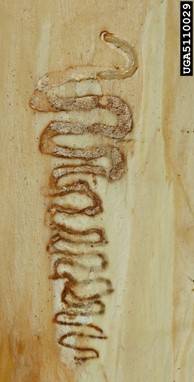Signs
Early detection of EAB in newly infested trees can prove very difficult, particularly for the lay property or woodland owner, as the trees tend to exhibit few, if any, visible external symptoms of infestation. The first symptoms to occur are cracks in the bark where the individual EAB have been feeding. As EAB populations build, woodpeckers learn to feed on them, causing uneven holes and flaking bark, signs easy to detect even from long distances. When trees begin to decline rapidly with further EAB population buildup, canopy thinning and epicormic sprouting (water sprouts) become more apparent. D-shaped adult emergence holes are small and hard to detect when there are few, but a reliable sign as populations build.

S-Shaped Larval Galleries and EAB Larvae
If you remove the bark and find frass-filled serpentine, S-shaped galleries tunneled just beneath the bark or etched into the underside of the bark, this is a definite sign of EAB infestation.
EAB Larvae
The presence of white to cream-colored, legless, flattened, 10-segmented, 1 to 1 1/2 inch (25 to 38 mm) long larvae found in the galleries beneath the bark of living ash trees is another definite sign of the presence of emerald ash borers. EAB larvae can separated from other beetle larvae by the “nested bells” look to their body segments.
D-Shaped Emergence Holes
A clear indication of EAB infestation is the presence of D-shaped holes chewed through the bark on branches or the trunk by adults as they emerge in late-spring. These holes are 1/8 inch (3 mm) in diameter. If the holes are not D-shaped, then they were not caused by EAB (native wood borer emergence holes are round or oval and are generally much larger, 1/4 inch (6 mm) or more). EAB usually starts infesting trees in the mid to upper part of the tree; therefore, in early infestations exit holes can be hard to spot from the ground.
Vertical Splits in the Bark
Thin, 2 to 5 inch (5 to 12 cm) long vertical splits through the bark of living trees. (Note, this symptom is not exclusive to EAB infestation.)
Woodpecker Damage
One of the first easily noticeable signs of infestation is often the presence of abundant bark flaking and uneven holes drilled by woodpeckers as they feed on EAB larvae and pupa.
Epicormic Shoots
Another symptom of a possible EAB infestation (but not limited to EAB) is the sprouting of epicormic shoots around the base of the tree or on the trunk. Epicormic shoots, or water sprouts, are shoots that often appear in trees due to stress or injury (such as defoliation or die-back) as a way for the tree to compensate for the loss of productive leaf surface.
Thinning Canopy
As the density of EAB infestation in an ash tree increases, the tree’s canopy will begin to thin out. When EAB first reaches an area it may take 5 years or more for trees to begin showing canopy symptoms. However, trees may die after only 2 to 3 years in areas of heavy infestation.
Monitoring and Detection of EAB
The first step in management and control involves monitoring and detection to determine if EAB is present.
Is the Woodpecker Damage Caused by EAB?
Woodpecker damage is easy to spot in winter and early spring and can be a reliable way to identify trees infested with EAB. However, woodpeckers go after many types of larvae on many types of trees. Here are some signs that indicate woodpecker damage was caused by EAB:
- The wood pecker damage is on an ash tree. Visit Ash Identification to see characteristics of ash trees.
- Fresh patches of the bark are flaked off producing a brownish color (see pictures above)
- In the flaked area there is a shallow hole where the woodpecker retrieved an EAB larvae from under the bark.
- At low population levels, wood pecks will be dispersed in a random or “checkerboard” pattern across the surface of the tree. When the population levels of EAB are high in an area, woodpecker damage can result in bark being stripped from large surfaces of the tree.
Cerceris fuminpennis
Cerceris fuminpennis are native predatory stingless wasps that can be used as an effective bio-surveillance tool. The female wasps capture and paralyze metallic wood-boring beetles, including the Emerald Ash Borer. They then provision their underground nest for their young to feed on. Once a Cerceris nest has been located, a volunteer can readily observe the wasp bringing in her prey. Beetles can be recovered from the Cerceris wasp by covering her nest entrance with a card that has a hole punched in it large enough for the wasp to pass through but too small for her to bring the prey beetle through. This forces the wasp to drop the beetle which can be recovered by the volunteer for identification. If EAB are found and confirmed, a closer inspection of surrounding ash trees is conducted.
Purple Traps
USDA APHIS (the United States Department of Agriculture Animal and Plant Health Inspection Service), in cooperation with state natural resources agencies and others, has instituted an EAB survey to identify the leading edge of known infestations and to locate new or outlying populations. Purple Prism Traps are not available to landowners, municipalities, or individuals. They are proprietary to the USDA and are only hung through their monitoring program.
Report a Sighting
Let others know where you have seen woodpecker damage on ash trees and what trees you are monitoring.
Visit iMapInvasives and choose one of the options on the lower left corner to report your sighting.
Call your local Cornell Cooperative Extension office.
http://cce.cornell.edu/localoffices
Or call the DEC Forest Health Information Line during business hours at (866) 640-0652.



